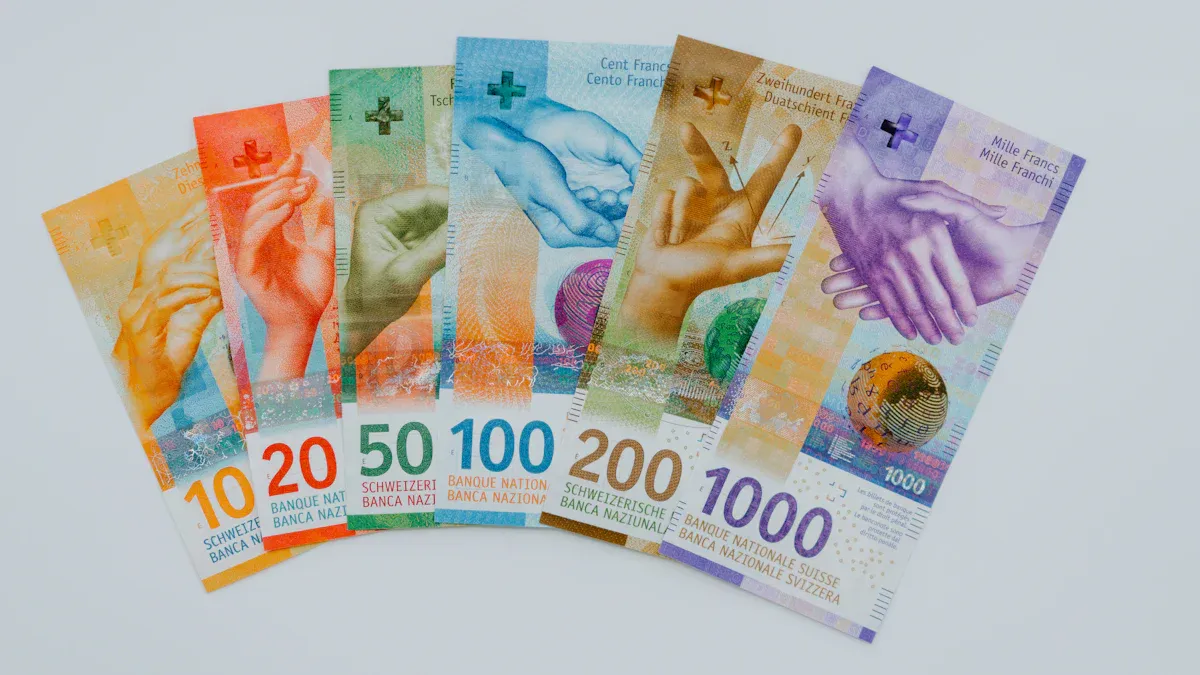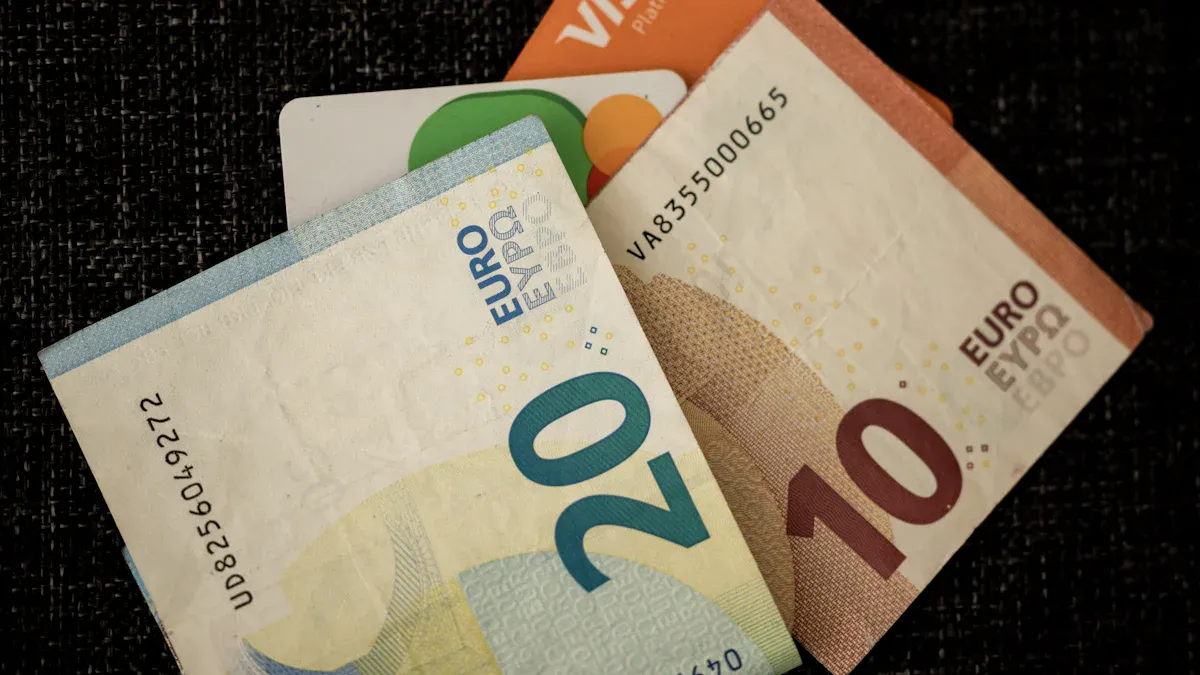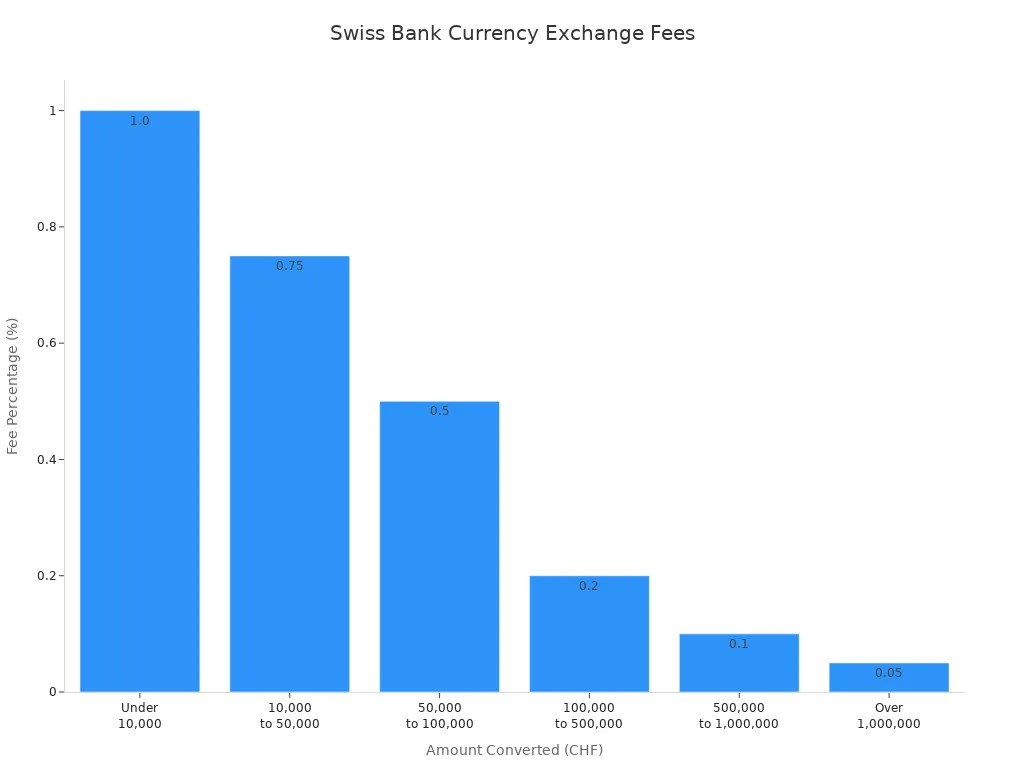- EasyCard
- Trade
- Help
- Announcement
- Academy
- SWIFT Code
- Iban Number
- Referral
- Customer Service
- Blog
- Creator
Can You Pay in Euro in Switzerland?

Image Source: unsplash
You can pay in euro in Switzerland at some locations, but the Swiss franc (CHF) remains the only official currency accepted everywhere. Many travelers want to use the euro because it feels convenient, especially when you travel from countries that use the euro. Shops near borders, hotel chains, and department stores in Switzerland often let you pay in euro. You may also find some restaurants or tourist spots that accept euros. However, small businesses usually do not accept euro, and most places give change in Swiss francs. When you pay in euros, the exchange rate often works against you, making your payment less valuable. If you travel to Switzerland, you should use Swiss francs or cards for payment to avoid extra charges and get better rates. Many travelers ask, “Can you use euros in Switzerland?” You can, but using the euro for payment is not always the best choice when you travel.
Key Takeaways
- Swiss francs (CHF) are the official currency and accepted everywhere in Switzerland.
- You can pay in euros in some tourist areas, hotels, and shops near borders, but acceptance is limited.
- Using euros often means worse exchange rates and getting change back in Swiss francs, which can cost you money.
- Debit and credit cards are widely accepted and offer better value and convenience than paying with euros.
- Plan to use Swiss francs or cards for most payments to avoid extra fees and get the best rates.
Currency in Switzerland

Image Source: unsplash
Swiss Franc (CHF)
You will notice that the official currency of Switzerland is the Swiss franc. When you travel or shop in Switzerland, you pay with francs, which use the code CHF. The Swiss franc has a long and interesting history. Before 1850, Switzerland had a confusing system with thousands of coins and banknotes from different regions. This made trade and travel difficult. Here is how the Swiss franc became the official currency of Switzerland:
- After 1815, more than 8,000 different coins circulated in Switzerland, issued by cantons and cities.
- In 1848, the Swiss Federal Constitution gave the federal government the power to issue money.
- On May 7, 1850, the Federal Assembly passed the Federal Coinage Act, creating the Swiss franc.
- The new currency used a decimal system and was based on the French franc, making trade easier.
- By 1852, the Swiss franc replaced all old coins and unified payments across Switzerland.
- The design of the coins showed Swiss unity and national identity.
- The Swiss franc has stayed stable and strong, which helps Switzerland’s economy.
You will see prices in CHF everywhere, from grocery stores to train stations. The Swiss franc is the only currency in Switzerland that everyone must accept.
Why Not the Euro?
You might wonder why Switzerland does not use the euro, even though many countries in Europe do. The answer is simple:
- Switzerland is not a member of the European Union (EU).
- The Swiss people have voted against joining the EU several times.
- Switzerland prefers to keep its own currency, the Swiss franc, to control its economy and stay independent.
- The country has special agreements with the EU, but these do not require using the euro.
Switzerland’s choice to keep the Swiss franc gives it more control over its money and helps protect its economy from outside shocks. The country can set its own rules for the currency in Switzerland, which is important for stability.
When you visit Switzerland, you will find that the official currency of Switzerland is always the Swiss franc, not the euro. You may see some places accept euros, but you should expect to use francs for most payments.
Where Can You Pay in Euro?

Image Source: pexels
Tourist Areas
When you travel to Switzerland, you will notice that some places make it easy to pay in euro. Tourist areas often display prices in both Swiss francs and euros. You can use the euro in many shops, restaurants, and souvenir stores in popular destinations. Cities like Zurich, Geneva, and Basel see many international visitors. These cities have more businesses that accept euros as payment. You will also find that border regions, such as those near France, Germany, or Italy, often let you pay in euro.
Here are some places where you can use euros in Switzerland:
- Airports, especially Zurich and Geneva, handle many international travelers and often accept euros.
- Major train stations, such as those in Zurich and Geneva, allow you to pay in euro for tickets and some services.
- Tourist-heavy spots, including museums, attractions, and large department stores, may accept euros.
Note: You will usually get change in Swiss francs, not euros, even in tourist areas.
Hotels and Shops
Many hotels and shops in Switzerland want to help travelers. You can pay in euro at many hotels, especially in tourist and border areas. Large department stores and chain shops in cities like Geneva and Basel often accept euros. Restaurants in these areas may also let you use the euro for your meal. However, you should know that not every business will accept euros as payment. Some public facilities, even in big cities, do not accept euros at all.
Most businesses that accept euros do so to help travelers. They know that many people travel from countries that use the euro. Still, Swiss francs remain the main currency. Debit cards are also very common for payment. If you want to spend euros in Switzerland, you should look for signs or ask before you shop or eat.
- Many hotels, restaurants, and shops in tourist and border areas accept euros, but not all.
- Businesses usually give change in Swiss francs.
- Some places, such as certain public facilities in Basel, do not accept euros.
Typical Conditions
When you use euros in Switzerland, you need to know the typical conditions. Most places that accept euros set their own exchange rate. This rate is often less favorable than the official rate. You may lose value when you pay in euro because of this. Businesses do this because they must convert euros to Swiss francs, which costs them money.
You will almost always get change in Swiss francs, not euros. This means you may end up with coins and bills you cannot use outside Switzerland. If you use the euro for small payments, you may not get the best value. For larger purchases, you should compare the cost in euros and Swiss francs.
| Condition | What to Expect |
|---|---|
| Exchange Rate | Often less favorable than official rates |
| Change | Usually given in Swiss francs |
| Acceptance | More common in tourist and border areas |
| Payment Methods | Debit cards and Swiss francs preferred |
Tip: If you want to use euros in Switzerland, do so only when you have no other option. You will get better value by using Swiss francs or a card that charges in CHF.
Can you use euros in Switzerland? Yes, but you should not rely on it for every payment. The acceptance of the euro is not universal, and you may face extra costs. Always check before you pay in euro, and plan to use Swiss francs or cards for most of your travel.
Use Euros in Switzerland: Pros and Cons
Exchange Rates
When you use the euro for payment in Switzerland, you often face less favorable exchange rates. Shops and hotels set their own rates, which are usually lower than the official interbank rates. This means you get fewer Swiss francs for your euros. For example, if you look at recent rates, the average exchange rate for the euro to CHF over the last 30 days was about 0.9339. However, the official mid-market rate can be higher, as shown in the table below:
| Time (CET) | Official Mid-Market Rate (CHF per EUR) | Radicant Bank Rate (CHF per EUR) |
|---|---|---|
| 11:00 | 0.9624 | 0.9623 |
| 13:00 | 0.9631 | 0.9628 |
| 15:00 | 0.9640 | 0.9637 |
| Day Average | 0.96512 | N/A |
You can see that the rates offered by banks or shops are often slightly lower than the official rate. This difference means you lose value each time you use the euro for payment.
Getting Change
If you use euros in Switzerland, you will almost always get change in Swiss francs. This can lead to extra costs. Shops and banks often add a margin of about 2% to the exchange rate. For example, if you want to get 2,500 CHF, you might need to pay about 2,747 euros at a rate of 0.91 EUR/CHF. You also risk losing more money if you have to convert francs back to euros later. Double conversions and hidden fees can make your trip more expensive. Online exchange services sometimes offer better rates and fewer fees, which can help you save money.
When to Use Euros
You may find it practical to use the euro in Switzerland if you are only staying for a short time or passing through. Many hotels, rail stations, and large shops accept the euro for payment. If you are in Switzerland for just one night or in transit, using euros can be convenient. However, the official currency of Switzerland is the Swiss franc, and you will get better value by using francs or a card that charges in CHF. For longer stays or bigger purchases, it is cheaper to use Swiss francs. Smaller shops and markets usually only accept francs, so you should plan ahead. Use euros in Switzerland only when you have no other option or when convenience is more important than cost.
How to Pay in Switzerland
Payment Methods in Switzerland
You have many payment methods in Switzerland. Debit cards now account for 35% of all store transactions. Cash payments in Switzerland have dropped to 30%, while credit cards make up 14%. Mobile payment apps, such as TWINT, Apple Pay, Google Pay, and Samsung Pay, are also popular. TWINT uses QR codes and is accepted at most places, but you need a Swiss bank account to use it. International cards like Wise and Revolut work well for tourists and offer good exchange rates. You can use cash for tipping or in places that do not accept cards. Public transport operators plan to reduce cash acceptance, so digital payment options are becoming more important.
- Debit cards are the most used payment method in stores.
- Cash or card in Switzerland both remain accepted, but cards are more common.
- Contactless card payments in Switzerland are very popular, with almost all cards enabled for this feature.
- Mobile apps and international cards give you more options for payment.
Using Cards
Card payments in Switzerland are easy and safe. You can use credit or debit cards in most cities and even in many rural areas. Contactless payments are available at 84% of payment terminals. You can also use mobile payment apps for quick transactions. When you pay with a card, you usually get charged in Swiss francs. Always choose to pay in the local currency to avoid extra fees from dynamic currency conversion. International cards like Wise and Revolut help you avoid high fees and offer better exchange rates. The best way to pay in Switzerland often involves using cards for convenience and security.
Exchanging Money
If you need to exchange money in Switzerland, banks offer fair rates but may charge fees. For amounts under $11,000, banks charge a 1% fee. Larger amounts have lower fees, as shown below:
| Amount Converted (USD) | Fee Percentage (%) |
|---|---|
| Under $11,000 | 1.00 |
| $11,000–$55,000 | 0.75 |
| $55,000–$110,000 | 0.50 |
| $110,000–$550,000 | 0.20 |
| $550,000–$1,100,000 | 0.10 |
| Over $1,100,000 | 0.05 |

You can use ATMs in Switzerland to withdraw cash, but some ATMs may charge operator fees. To avoid extra costs, follow these tips:
- Use travel cards like Wise for low fees and good exchange rates.
- Always pay in Swiss francs when using cards.
- Make larger ATM withdrawals to reduce fixed fees.
- Avoid exchanging money at airports or tourist spots.
- Order currency in advance from your bank for better rates.
- Use multi-currency accounts to manage your spending.
You have many options for how to pay in Switzerland. ATMs in Switzerland are easy to find, and you can use them for both cash and card withdrawals. Cash or card in Switzerland both work, but card payments in Switzerland are usually the most convenient. If you plan ahead, you can avoid high fees and get the best rates when you exchange money in Switzerland.
When you travel in Switzerland, you get the best value by using Swiss francs or paying with cards. Euros work in some places, but you often lose money because of poor exchange rates and get change in Swiss francs. Most travelers find that using Swiss francs is easier and more cost-effective.
- Swiss francs are accepted everywhere in Switzerland.
- Card payments are simple and widely used.
- Use euros only if you have no other option during your travel.
Plan your travel budget before you arrive so you avoid surprises.
FAQ
Can you use euros everywhere in Switzerland?
You cannot use euros everywhere in Switzerland. Most places only accept Swiss francs. Some hotels, shops, and tourist spots let you pay in euros, but you should always check before you travel or shop.
What is the best way to pay when you travel in Switzerland?
You get the best value by using Swiss francs or paying with a card. Most stores and restaurants accept cards. If you travel with cash, use Swiss francs for most purchases.
Will you get change in euros if you pay with them?
You will almost always get change in Swiss francs, not euros. This can make your travel less convenient if you want to use the leftover money in another country.
Do Swiss ATMs accept foreign cards for travel?
Swiss ATMs accept most foreign cards. You can withdraw Swiss francs for your travel needs. Some ATMs may charge a fee, so check with your card provider before you travel.
Should you exchange money before you travel to Switzerland?
You should exchange some money before you travel. This helps you pay for small things when you arrive. You can also use ATMs or cards for most payments during your travel.
When traveling in Switzerland, currency conversion needs due to limited euro acceptance can add extra costs. BiyaPay offers an efficient solution with real-time exchange rate queries and conversions, supporting over 30 fiat currencies and 200+ digital currencies with seamless flexibility, and remittance fees as low as 0.5%, covering over 200 countries and regions with same-day remittance delivery. Plus, its quick registration, no-overseas-account-needed US/HK stock investment features, and the launched Easy Card service (enabling easy global payments) enhance your cross-border payment options. Experience these benefits now to optimize your Switzerland travel payments! Whether exchanging Swiss francs or handling cross-border remittances, opt for BiyaPay for worry-free financial management.
*This article is provided for general information purposes and does not constitute legal, tax or other professional advice from BiyaPay or its subsidiaries and its affiliates, and it is not intended as a substitute for obtaining advice from a financial advisor or any other professional.
We make no representations, warranties or warranties, express or implied, as to the accuracy, completeness or timeliness of the contents of this publication.




Contact Us
Company and Team
BiyaPay Products
Customer Services
is a broker-dealer registered with the U.S. Securities and Exchange Commission (SEC) (No.: 802-127417), member of the Financial Industry Regulatory Authority (FINRA) (CRD: 325027), member of the Securities Investor Protection Corporation (SIPC), and regulated by FINRA and SEC.
registered with the US Financial Crimes Enforcement Network (FinCEN), as a Money Services Business (MSB), registration number: 31000218637349, and regulated by FinCEN.
registered as Financial Service Provider (FSP number: FSP1007221) in New Zealand, and is a member of the Financial Dispute Resolution Scheme, a New Zealand independent dispute resolution service provider.


















